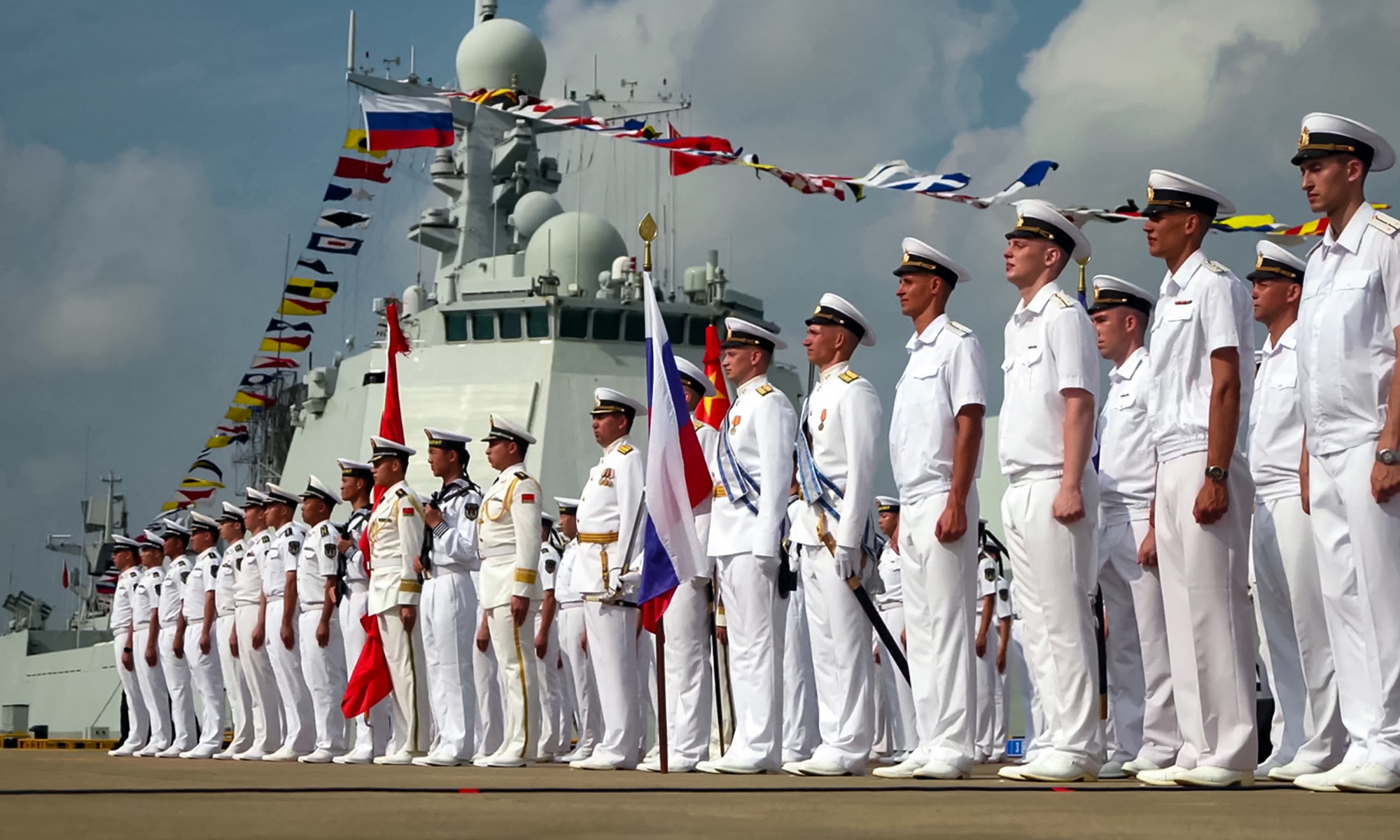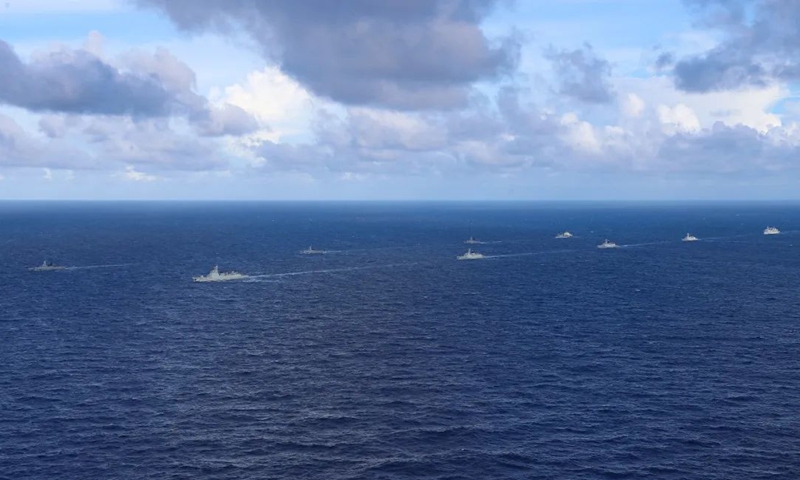
A screenshot of a handout footage released by the Russian Defense Ministry on July 15, 2024 shows Russian and Chinese sailors taking part in the opening ceremony of a joint maritime exercise at a port in Zhanjiang, South China's Guangdong province. Photo: AFP
China and Russia have wrapped up a naval exercise in which warships from the two navies conducted live gun and missile firing in waters off China's southern coast, with experts on Thursday highlighting the high-level actual combat orientation displayed throughout the drill and the continued boosting of China-Russia military cooperation.
After having completed all of the scheduled training courses, the China-Russia joint warship formation participating in the Joint Sea-2024 military exercise conducted a farewell ceremony in waters near Zhanjiang, South China's Guangdong Province, on Wednesday afternoon, marking the conclusion of the six-day drill, the Chinese People's Liberation Army (PLA) Navy said in a press release on Thursday.
United under the goal of dealing with maritime security threats, the two countries' navies
sent seven warships to the exercise, namely the Type 052D destroyer
Nanning, Type 054A frigates
Xianning and
Dali, Type 903 comprehensive supply ship
Weishanhu from the Chinese side and the corvettes
Gromkiy and
Rezkiy as well as the oiler
Irkut from the Russian side, China Central Television (CCTV) reported.
In the harbor phase from July 12 to Sunday, the two sides carried out table wargames, professional exchanges, vessel visits, as well as friendly exchanges including tai chi practices, sports competitions and deck receptions. After the launch of the sea phase on Monday, the participating forces from the two sides coordinated closely and tacitly in multiple live training courses including joint reconnaissance and early warning, joint search and rescue as well as joint air and missile defense, according to the PLA Navy.
During a joint air and missile defense training session on Wednesday morning, Chinese destroyer
Nanning and Russian corvette
Gromkiy were tasked to intercept incoming high-speed anti-ship missiles simulated by target aircraft, the PLA Daily reported.
The
Nanning launched a ship-to-air missile and shot down a target, while at the same time, the
Gromkiy, several nautical miles away from the Chinese destroyer, fired multiple rounds with its naval gun and intercepted the other target, the report said.
"Making sure friendly fire is avoided and based on the areas of attack and weapon performances of each ship, the command center organized the two Chinese and Russian vessels to conduct simultaneous attack against the targets by optimally distributing the targets and choosing the methods of attack at the shortest notice," the PLA Daily quoted a Chinese staff officer as saying.
The exercise enhanced the Chinese and Russian navies' professional exchanges, mutual understandings and mutual trust, and promoted the high-level standardization and systematization in the two sides' pragmatic cooperation, the PLA Navy said in its press release.
Since 2012, the Joint Sea series of drills have become a main platform for the two countries' naval cooperation that have enhanced the level of maritime joint military operation from all perspectives, as the two navies continue to boost their capabilities in jointly dealing with security threats and challenges, the PLA Navy said.
The commander of the naval formation was quoted as saying that the exercise optimized the coordination mechanism between the two sides and enhanced interoperability among their ships, displaying China's and Russia's firm determination in jointly safeguarding maritime and regional peace and stability.
A Chinese military expert who requested anonymity told the Global Times on Thursday that the China-Russia joint exercise displayed a high level of actual combat orientation.
Take the air and missile defense training session.As anti-ship missile is one of major threats to warships in modern warfare, the exercise practiced interception with live gun and missile fires, the above-quoted expert said.
It was also full of details on a tactical level. For example, the command center considered friendly fire and the distribution of different targets to different ships, which are concrete challenges that only arise in real practices, the expert said.
Also highlighting the combat orientation of the exercise, Zhang Junshe, a Chinese military expert, told the Global Times on Thursday that both navies sent some of their new and main combat vessels to the drill that boast strong comprehensive combat capabilities.
The setting of the training courses was also combat-oriented, as they were chosen based on the actual needs in naval combat, Zhang said.
In another development, China and Russia also held their fourth joint naval patrol in the Asia-Pacific region from early July to mid-July.
The China-Russia joint naval formation started the joint patrol in waters to the south of Jeju Island, made a transit through the Osumi Strait and sailed south through the West Pacific before entering the South China Sea via the Balintang Channel, CCTV reported on Tuesday.

A China-Russia joint warship formation completes all training courses in the Joint Sea-2024 military exercise in waters near Zhanjiang, South China's Guangdong Province, on July 17, 2024. Photo: Screenshot from the WeChat account of the PLA Navy
Photos released by the PLA Navy showing the farewell ceremony of the Joint Sea-2024 exercise featured a total of nine Chinese and Russian warships, more than the seven vessels that took part in the exercise.
It is likely that warships in the joint patrol joined up with warships in the joint exercise, observers said.
Not targeting third partyWestern media linked the China-Russia naval cooperation to the recent tensions in the South China Sea, with the Philippines, under US' instigation, repeatedly provoking China vis-a-vis the Chinese islands and reefs in the region. Western media also hyped the joint exercise's connection to the Russia-Ukraine conflict and "confronting NATO."
Chinese experts refuted such claims, saying that the Joint Sea series drills have been held multiple times since 2012 across many different waters near China and Russia, and while the exercise was combat-oriented, it did not set a third party as a target.
Western media's hyping only exposed their guilty conscience in attempting to sabotage normal China-Russia military cooperation, analysts said. They stressed that unlike the US that aims to maintain its global military hegemony, The China-Russia military cooperation provides stabilizing factors to the deteriorating global and regional security, analysts noted.





